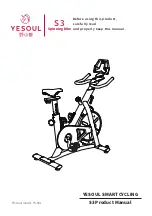
special tools, so only an experienced bicycle mechanic at a Cannondale retailer
should perform this job. Damage to the fork due to contamination by water or
dirt will not be covered under warranty.
Inner Steerer Tube: Several times a year, or if the suspension boot has been
damaged, or if the fork has taken a large or unexpected impact, you should
inspect the inner steerer tube beneath the boot. Before proceeding, make sure
that you have two replacement zip ties to reaffix the HeadShok boot. These
should be available from your Cannondale retailer. Cut both old zip ties off of
the boot and pull the boot up off of the lower boot mount and down off of the
lower collar. Clean the area inside the boot of any dirt and old grease. Inspect
the inner races and the steerer tube for corrosion, cracks, or a bent steerer
tube. Also be sure to slide the large O-ring bottom-out bumper up off of the
crown and carefully check this area.
If there are any cracks on the steerer assembly or if it is bent at all, the fork
must be replaced immediately.
DO NOT CONTINUE TO RIDE.
If rust, pitting,
or corrosion is present on the steerer tube, you should take the fork to a
Cannondale retailer for inspection and to evaluate the amount of structural
damage that may have resulted.
WARNING:
WARNING:
Serious, structural corrosion on the inner
steerer tube of a HeadShok fork will decrease the useful life
of the fork. Corrosion or cracks on the steerer tube, or a bent
steerer tube, may lead to the failure of the fork, which could
cause an accident with attendant risk of injury or death.
HeadShok forks that show signs of such structural damage
in the steerer tube must be replaced immediately.
After completing inspection of the HeadShok steerer tube assembly lightly coat
the exposed length of the inner steerer tube and bearing races with a good
quality light bicycle grease, such as Finish Line White Teflon grease, Slick 50
One Grease, or Royal Purple grease (Cannondale part # HD225/). Be sure to
slide the large O-ring bottom-out bumper up from the crown and thoroughly
grease under the O-ring at the junction between the bottom of the inner steerer
tube and the fork crown.
Replace the boot onto the lower collar of the HeadShok telescoping assembly
and to the top of the fork crown. Reattach the boot with two zip ties. Make sure
that the zip ties are secured tightly.
For the majority of riders the standard springs, once preloaded for a rider, will
work fine. Some riders with different preferences may need different springs. As
the chart indicates, there are additional springs available from Cannondale for
the HeadShok fork and from Fox for the rear shock. We urge you to have your
retailer change springs.
Do not attempt to adjust the preload or touch the spring or swingarm
while seated or riding. Suspension movement could cause you to pinch or
injure your fingers. Keep your hands away.
HeadShok scheduled maintenance:
It is recommended that you take your
Easy Rider to your Cannondale retailer for a fork tune up every 6 months or 60
hours of riding. Your fork is a high performance suspension system and needs
regular inspection, lubrication, and maintenance. The mechanic will check the
following items and service as necessary. Between tune ups, you will also want
to check your fork as outlined below.
Frame and Fork: Once a month, or every few rides, clean and inspect the entire
frame and fork for any dents, cracks, or other damage. If any damage to the
frame or fork is found, do not ride the bicycle. Have the damage inspected by a
Cannondale retailer.
Headset Bearings: Periodically, particularly after the bicycle is exposed to a lot
of water (rain, mud, or washing) a few drops of lightweight oil (such as Pedro’s
Syn Lube) should be smeared around the upper headset bearing (located just
below the stem). The rubber seal in the top of the bearing must be kept
lubricated, as it protects the headset cartridge bearings from contamination by
water and dirt. Failure to keep the headset bearing lubricated will result in
premature bearing wear.
Suspension Fork Boot: Frequently inspect the rubber boot at the base of the
head tube for tears, cuts, or broken zip ties that could allow contamination. The
fork boot protects the needle bearings and bearing races from water, dirt, and
other contaminants. Make sure that the shifting and brake cables have not
rubbed a hole in the boot. If the cables are rubbing on the boot, you should re-
route them to eliminate the contact. Your Cannondale retailer can help you with
this procedure.
If the boot is damaged in any way, it must be replaced immediately. Boot
replacement requires the suspension fork be removed from the frame using
16
17






























